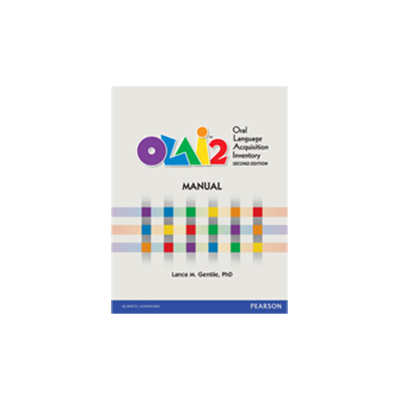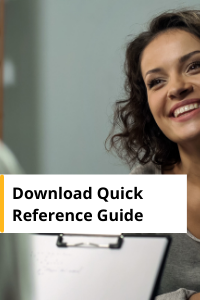Lance Gentile, PhD
Overview:Systematic, integrated assessment and intervention/ instructional tool for language, literacy, and learning behavior
Age Range:PreK–Grade 6
Administration:Paper-and-pencil (audio recorder recommended for some parts)
Scoring Option:Manual Scoring
RTI Tiers:RTI Levels 2 and 3
Completion Time:About 20 minutes
Scores/Interpretation:Raw score percentages and an individual profile of language and literacy structures and learning behaviors
Publication Date:2011
The OLAI-2 continues the OLAI tradition of using quick and simple criterion-referenced assessment tasks to evaluate language and learning behaviors in order to drive effective instruction and/or intervention. Even better, a new format for the included instructional activities allows you to integrate the activities into your daily work immediately. Designed for an expanded age range, including ELL students, the OLAI-2 offers you a new look at how children learn language and what you can do to support their learning.
Users & Applications
SLPs, Reading Recovery teachers, general and special educators, and administrators alike will find wide usability of the OLAI-2. In particular, you may use the assessment portion of OLAI-2 in the following contexts:
- Tier 2 or 3 benchmarking
- Progress Monitoring in any context
- Part of a diagnostic assessment In general, the assessment portion of the OLAI-2 helps you to identify an appropriate stage of language and literacy development that is typical for a child learning English (including children who are ELLs) and understand how the child’s learning behaviors may impact the process of mastering English and its use.
You may consider the instruction/intervention portion of the OLAI-2 in the following contexts:
- Any tiered or supplemental instructional support in general education or an RTI program
- Individual or small group special education intervention
The intervention/instructional portion of the OLAI-2 helps you to guide language interactions to increase opportunities for children to talk about text as well as enhance the student’s ability to read and write for meaning. The OLAI-2 offers a listening, speaking, reading, and writing focus for daily interactions with students.
Content and Administration
The OLAI-2 content is divided into two groups, PreK–Grade 3 and Grades 4–6. Each grouping has three equivalent forms (A, B, and C) to enhance the student’s experience with frequent monitoring.
PreK–Grade 3 Sections:
- Phonemic Awareness
- Print Concepts
- Repeated Sentences
- Story Retelling & Comprehension
- Learning Behavior
Grades 4–6 Sections:
- Phonemic Awareness
- Repeated Sentences
- Expository Reading & Writing
- Learning Behavior
Scoring for each section includes a simple calculation of percentage correct and an assessment of learning behavior. Then, the OLAI-2 Performance Profile allows you to select the appropriate stage of language, literacy, and learning behavior for each section and then for the total performance. The Performance Profile gives you an “at-a-glance” view of both language-and literacy-based skills as well as key information about the student’s learning behavior, so you can address both the skill and the approach to learning in your intervention/instruction.
Features & Benefits
- Offers an expanded age range—now through Grade 6
- Manual includes case studies at each grade range
- Integrates ready-to-use Intervention/Instruction activities
- Simplified scoring; use of a Performance Profile to see a “snapshot” of the student’s responses
- Content includes both oral language and emergent literacy/literacy content areas in an easy-to-use and understandable way
- Reduced administration time from the previous version
- Newly designed and easy-to-use record forms
- Three equivalent forms at each grade level make progress monitoring easier and reduce the impact of familiarity on the assessment results
Materials
The OLAI-2 complete kit contains the following
 components:
components:
- Manual—now including assessment and intervention/instruction activities all in one place!
- Picture cards for narrative and expository text tasks
- Six sets of record forms (PreK–Grade 3, Forms A, B, and C; Grades 4–6, Forms A, B, and C)
In addition, the Spanish materials of the original OLAI version are still available. Both the assessment and the instructional guide may be purchased in Spanish. Components include:
- Inventario de la adquisicion de la expression oral (Inventario)
- Guia para la instruccion de Oracy: Un texto bilingue (Guia)
The Oracy Instructional Guide/Guia para la instruccion de oracy is the companion to the OLAI/Inventario linking research and theory to assessment and instruction. The Guide/Guia contains a variety of appropriate activities for each stage of language development. Explicit examples of procedures and content show teachers how to modify interactions with students in Spanish during intervention in oral language development, story retelling and to help students develop positive responses when learning is stressful.
Materials
Pre-recorded Webinars
-
The Oral Language Acquisition Inventory, Second Edition (OLAI-2)
Presenter: Lance M Gentile, PhD

This is a research based assesment containing three specific areas of emphasis: Language Structures, Story Retelling and Learning Behavior. The instrument was developed, in English and Spanish, from the author’s actionable studies and field work to meet the needs of many students in today’s classrooms who are least experienced in these areas of development. Results provide teachers a model of measurement that translates directly to intervention. The OLAI and Inventario are very helpful for testing and teaching Tier II and III students according to the Response to Intervention (RTI) Legislation. They are sensitive enough to identify growth over short periods of time for those students who do not demonstrate anticipated progress during regular classroom instruction. The OALI and Inventario establish five stages of language development and provide a clear index of value added progress in each area of measurement across grade levels. They contain the information needed to apply results to effective teaching and intervention.
The Oracy Instructional Guide/Guia para la instruccion de oracy is the companion to the OLAI/Inventario linking research and theory to assessment and instruction. The Guide/Guia contains a variety of appropriate activities for each stage of language development. Explicit examples of procedures and content show teachers how to modify interactions with students during intervention in oral language development, story retelling and to help students develop positive responses when learning is stressful.
Date: Mar 18, 2013
-
Assessing Oral Language Development and Early Literacy
Presenter: Adam Scheller

During this webinar, Adam will review relevant research regarding the correlation of oral language acquisition with reading, as well as the key pre‐reading skills necessary for children to become effective readers. We will discuss a process for assessment wand case study using the Oral Language Acquisition Inventory, 2nd edition and Woodcock Reading Master Test, 3rd edition.
Date: Jan 23, 2013
Questions
Frequently asked questions follow. Click on a question to see the response.
Administering the OLAI-2
-
Regarding Story Retelling, our team has had several discussions about the dual scoring of story elements and word count, as well as questions regarding the use of prompting. Can you clarify this task?
-
When administering Expository Reading, should the examinee have the text in front of him/her for the intra- and extra- personal questions?
-
On the phonemic awareness portion of the assessment, when you give the prompt “Can you say the /l/ in lions?” Do you then give a point if the student is able to produce the sound after the prompt? Or do professionals give a zero? Some professionals have had to use the prompt for every sound in every word.
-
For Phonemic Awareness, may I give one example before starting so the student understands the task? Or may I tell the student, “I want you to identify the sound, not the letter?” Some professionals feel it would help the student to understand the task a little better first.
-
For the upper grades, what if I have to read the story for the student in the fall, and then for the winter assessment they are still unable to read the passage on their own? The manual says I only read the passage for the student on the first assessment. If they are unable to read the passage for the second assessment, then do we simply give them zero scores for the questions and the summary?
-
In the original OLAI, I used to give a sample/practice sentence before beginning the Sentence Repetitions portion of the assessment. May I still give a sample/practice sentence now?
-
For the Story Retelling portion of the assessment, the manual on page 24 mentions that we may need to provide some prompts to ELLs during their retelling. Is it okay to ask about the story elements (character, setting, problem, resolution) or is that leading them too much? If it is okay to ask for the story elements, do they get a point for the correct response if we had to prompt them first?
Questions and Answers to Dr. Lance Gentile, author of the OLAI-2
-
What is the role of standardized testing in the schools, in your opinion?
-
Is the level of language used in OLAI-2 also required for understanding common instructional directions?
-
What would you say to teachers who have struggling students but do not feel they have time to respond to individual needs?
-
What would you say to teachers who have struggling students but do not feel they have time to respond to individual needs?
-
Dr. Gentile, do you have any age-of-acquisition norms for syntactic forms?
-
Are there any suggestions for underachievers experiencing reading difficulty on the high school level?
-
In Story Retelling, I have just been counting the total number of words the child uses to retell. I wonder if this is correct – must a child use the specific nouns, verbs, adverbs, and others that were in the story? What about repeating a word – are words used more than once counted more than once? What about articles, prepositions, and conjunctions – are they included in Word Count?





